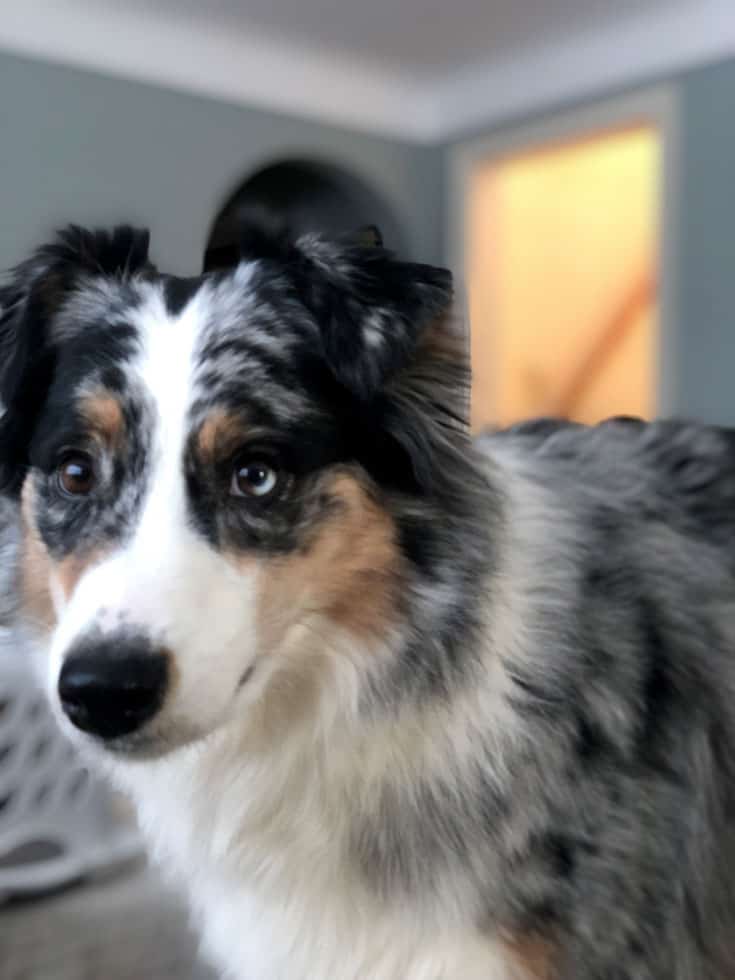Australian Shepherds with different colored eyes, or heterochromia, is due to genetics. Not every Aussie is born with these colorful eyes.
You can still remember the first time you laid eyes on your Australian Shepherd. Yes, there was that overwhelming feeling of love you had, but also, you couldn’t help but notice that their eyes were two different colors. You haven’t seen that in any breed of dog you own. Why is it that an Aussie’s eyes are so unique?
In this article, we’ll tell you everything you need to know about Aussie eye color. From which colors your dog’s eyes may be to other traits possessed by Australian Shepherds with heterochromia, keep reading. You’re not going to want to miss this!

What Colors Can an Australian Shepherd’s Eyes Be?
Most dog breeds have a few options for eye colors. The most common hues are hazel, golden, speckled, or light blue. Australian Shepherds boast an eye color range that’s almost more reminiscent of us humans.
Their eyes can be green, amber, hazel, blue, or brown. That beautiful color range is just one reason of many to fall in love with an Australian Shepherd. If your dog has heterochromia, you’ll appreciate their stunning eyes even more.
Why Do Aussies Have Different Colored Eyes?
What is it about Aussies that causes them to have heterochromia? It all comes down to genetics.
Those two different eye colors, which is also known as wall eye, is one trait of many in dogs that their mother and father canine can pass down. With two parents, a puppy’s gene copies double.
Sometimes, these genes conflict with one another. In such a situation, the mother’s genes will always dictate what the puppy will look like. That’s due to the dominancy of the mother’s genes over the father’s.
If both parents share the same genes, then there’s no question the offspring will exhibit the traits the gene is expressed for. That’s the only way a puppy will be born with wall eye, by the way, is if both the mother and father share the heterochromia gene.
The parent dogs don’t even need to have wall eye themselves. If the gene is within them, then some of the puppies in the litter will be born with two eye colors. It’s very unlikely they all will, though.
By the way, as cool as wall eye is, it’s not unique to Aussies.

Other dog breeds that may have different colored eyes are:
- Shih-tzus
- Dalmatians
- Border Collies
- Shetland Sheepdogs
- Great Danes
- Australian Cattle Dogs
- Siberian Huskies
- Dachshunds
- Chihuahuas
Even animals outside of dogs may sometimes have wall eye. Cats, wolves, rabbits, owls, mice, monkeys, and horses can exhibit slight or more overt color differences from one eye to another. It’s more common for animals to be heterochromatic than people, but lots of humans have different eye colors too.
What Other Traits Are Specific to Australian Shepherds with Different Colored Eyes?
If you look at an Australian Shepherd puppy with wall eye and compare it to others in the litter with one eye color, you may notice something else about the dog. The wall eye pup tends to have a unique coat color. Your dog’s fur may feature white streaks throughout and sometimes even a dappled pattern on the coat.
A dog’s coat color and eye color gene share a link, so if a dog has wall eye, their coat will always be different than a dog born without wall eye.

My Australian Shepherd Has One Eye Color. Is Something Wrong?
You didn’t even know Australian Shepherds could be heterochromatic. Yours certainly isn’t. Does that mean something is wrong with your pup?
Not at all! As we explained earlier, whether a dog has wall eye all comes down to genetics. Your pup’s brother or sister could have heterochromia because both their parents carried the gene for it, but your dog just wasn’t born that way.
It’s not a sign of poor health for an Aussie to not be heterochromatic. In fact, two different eye colors can sometimes be an indicator of health issues.
For example, some animals develop their heterochromia because of disease or illness. This isn’t congenital heterochromia, which means the animal was born with two eye colors. Rather, it’s called acquired heterochromia, which means the eye color changes happened after birth.
Also, if your Aussie has one blue eye, that eye may be weaker than the other eye of different a color according to this report. Now, this doesn’t necessarily guarantee your Aussie will go blind, but they could develop vision difficulties, especially as they get older.
We’d recommend you take your Shepherd in at least every year for a veterinary checkup and make sure their eyes are inspected while you’re there. Your vet should pay special attention to the blue eye.
Can You Breed for Aussies with Different Eye Colors?
As you’ve read this article, you’ve looked deeper into Australian Shepherds with heterochromia. It’s such a cool look. You’d love to take your dog and another Aussie and breed for a wall-eyed puppy. Can you?
It’s possible but very unlikely.
A few things are actively working against you here. For one, you’d have to find two dogs with the dominant gene for heterochromia. Remember, these dogs don’t have to exhibit wall eye themselves. If you don’t know whether your dog has the gene (and how would you if he or she is going to be a first-time puppy parent), then it’s all just a guessing game.
You’d then breed the dogs together without knowing what the results will be. This is time-consuming, not to mention expensive. You must care for the pregnant Aussie until she gives birth. Then you’re in charge of the veterinary care of the litter for at least eight or 12 weeks or until someone wants to adopt them (unless you keep them).
Okay, so what if you just find two adult dogs with heterochromia? Again, the results aren’t guaranteed. Think of your own parents. Do you share every last trait with them just because you’re a direct descendent of theirs? No. Your parents may have blonde hair but yours is brown, or perhaps you have green eyes, but your dad’s eyes are blue.
Traits can “skip” a generation, so some traits your grandparents have may have missed your mother but were passed down to you. It’s all about which gene is the most dominant. That’s what determines who we are and what we look like.
The same is true of dogs. To reiterate then, there are no promises two heterochromatic adults would yield a pup with wall eye. Plus, responsible dog breeders will never let two dogs with wall eye breed. The puppies tend to be deaf and blind, so their lives will be very difficult. It’s not worth all that trouble to try to get a heterochromatic puppy.
If you happen to adopt an Aussie with wall eye, then congrats! That’s fantastic. Enjoy what you have, but don’t go looking for it intentionally.
Australian Shepherds With Different Colored Eyes :: In Conclusion
Some Australian Shepherds have what’s known as heterochromia or wall eye. This is when the dog is born with two different eye colors. Some other dog breeds look like this as well, as do plenty of other animals. People can be heterochromatic too!
In Aussies, wall eye comes down purely to genetics. Both parents must possess the gene, but they don’t need heterochromia. Shepherds with two different eye colors are generally healthy, although blue eyes may cause some vision difficulties.
Now that you know about Australian Shepherd heterochromia, you can appreciate your dog more no matter their eye color.

